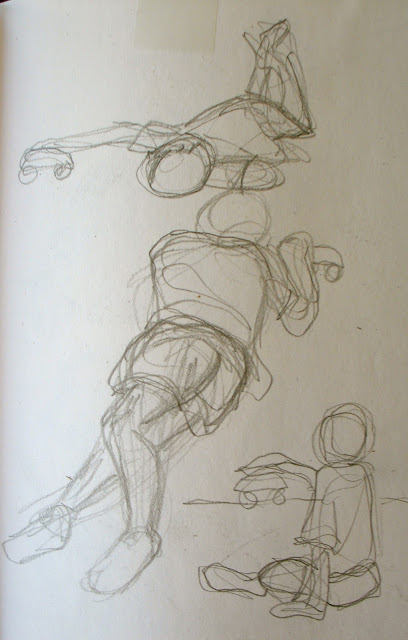In every watercolor painting, you will use some combination of at least 3 of these techniques.
1. WET-ON-WET FLAT WASH --
The entire shape is wet with clear water, then the color is added. The color fills up the shape pretty easily.
2. WET-ON-DRY FLAT WASH --
This wash is a little more difficult -- especially with a large shape. It's important that your paper/board is slightly inclined, and that you have enough paint/water on your brush to make a "bead" at the bottom of each stroke.
With each subsequent stroke, you just pick up the "bead" only, as you work your way down the shape. Never go back into what you have just painted.
3. WET-ON-WET GRADED WASH --
Again, the entire shape is painted with clear water first. Then, the paint is applied to the top of the shape only. If the board in inclined, the water will do the rest of the work.
4. WET-ON-DRY GRADED WASH --
You have more control here, but you still have to be careful not to go back into what you've just painted with your loaded brush. Keep your paper inclined, so that you have a bead. This time, every time you go back to the palette, you add more water to your mixture, before adding it to your paper. By the bottom of your shape, you will be painting with clear water.
5. MINGLING (MULTI-COLOR WASH) WET-IN-WET --
Paint two or three different colors on a wet surface. In this case, the paper/board should be level.
6. VARIEGATED WASH WET-ON-DRY --
With your board slanted, and a few puddles of 3 different colors ready, start painting a wash of one color at the top. Rinse your brush, and then start painting with the 2nd color, picking up the bead of the 1st color. Then, rinse your brush, and finish the painting with the 3rd color.
7. SALTING --
Salting is a technique that gives the illusion of texture. After painting a wash, wait until the surface has a sheen on it -- then, sprinkle some salt onto the surface. When it is bone dry, brush off the salt.
8. SANDING --
This is another texture technique. After painting a wash, while it is still wet, rub the point of a watercolor pencil on a sandpaper block.
9. RESIST/MASKING --
Draw some lines with masking fluid on dry paper, and let it dry completely. Then, paint a wash over it, and let that dry. Then, rub off the masking fluid, to reveal the white lines.
10. LIFTING --
Paint a wash and let it dry completely. Then, draw some lines with clear water -- then, blot with a paper towel.




















































